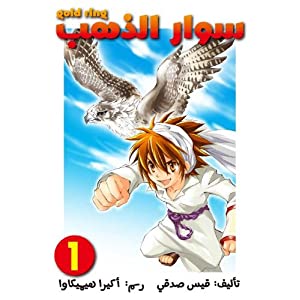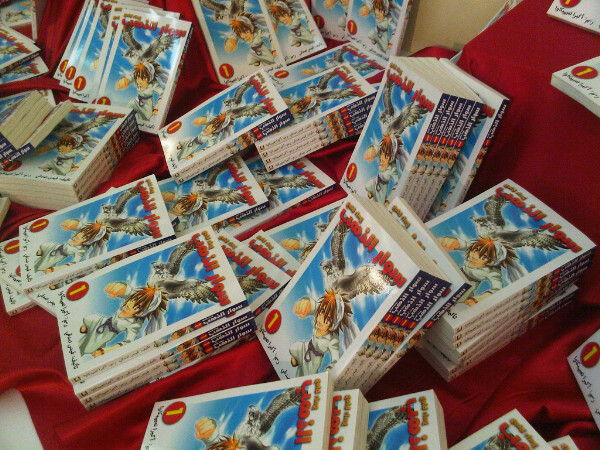
Manga and anime have always been popular in the Arab world. In the '70s and 80s, when Americans were watching abysmal home-produced animation, Arab audiences got to see translations of major anime TV series like The Rose of Versailles, Future Boy Conan and Mazinger Z. Unfortunately, in the last twenty years the amount of anime in Arabic has dwindled, at least the amount of non-pirated anime, owing in part to the fact that most of the major dubbing studios were in Iraq and collapsed in the military and economic chaos of the first Gulf War. (How's that for human cost?) But there are still many Arab and Muslim anime fans; even the ridiculous Jojo's Bizarre Adventure Qu'ran controversy, in which right-wing Muslims complained over the depiction of Qu'rans and mosques, wouldn't have been possible if the series hadn't been fansubbed by Arabic anime fans, who presumably translated it because they liked it and not to show to the cranky fundamentalists at the Egyptian religious school Al-Azhar.

Gold Ring ("Siwari Al-Dhahab"), an Arabic manga written by United Arab Emirates author Qais Sedki and drawn by a pair of Japanese mangaka who use the pen name Akira Himekawa, builds on this tradition of Arab-Japanese pop culture love. "I've always had a fascination with Japanese culture…my generation grew up with the stuff, so we're very accustomed not just to the aesthetic, but to the quirks in manga that are very Japanese," Sedki said in an interview with CNN. Published in the United Arab Emirates in Arabic only (for now at least) and available in English by mail-order, it's not really intended for English readers; but then again, neither is any manga, so what's wrong with that? And one advantage of doing an OAL (Original Arabic Language) manga is that Arabic, like Japanese, reads right to left. For Sedki, a former IT consultant and founder of the publishing company Pageflip, it's the first in a series and apparently the first graphic novel from the Emirates. For myself, as someone who is studying Arabic and likes manga, it's certainly an easier teaching tool than starting with the works of Ghassan Kanafani.
Sultan is a young boy in an unnamed Arabic country (presumably the Emirates) who lives with his widowed mother. Together with his friend Ziad, he sneaks backstage to watch the Gold Ring falconry competition, where falconers from all around the Arab world compete to show their falcons' speed and training and the powerful bond between man and bird. When Ziad finds a caged falcon and wants to sell it for money, Sultan has pity on it and convinces Ziad to release it into the wild instead. But the next morning the bird is back outside Sultan's window! Sultan names the bird Majid, and with the help of a Gold Ring tournament official named Hassan (who is a dead ringer for Qais Sedki), he learns the path of falconry and prepares to enter the competition.
With everything from a young boy in a competition to a fondly remembered absent father, Gold Ring is pure shonen manga. The idea of using falconry in a manga-style competition is genius, given that it's possibly the only situation in the real world where someone really can train a wild animal, carry it around with them, and send it out to fetch things or kill other animals. (The Gold Ring tournament lessens the violence by having the falcons hunt mechanical pigeons, but in the scenes outside the tournament a few mice and birds get killed.) As the first volume progresses, Sultan even goes out in the wilderness to train with Saroor, a mysterious old master of falconry, and gets into desert adventures with hyenas, snakes and leopards
Although Sultan and Majid's insta-bond is the stuff of stories, the series tries to portray the realities of falconry, showing all the real equipment (the hood, the glove, the little ball of feathers on the end of a rope, etc.) and the steps of training, and even including a brief appendix of tools at the end. When Sultan is able to command Majid from a distance with just hand signals, it's a victory. The first volume ends just as Sultan has ended the qualification trials to participate in the tournament, and ends with the introduction of his future rivals: the arrogant young Bedouin-esque "desert noble" Farras, the Turkish bird-and-master duo Marjan and Yasqut, and sinister blonde guy Lucas, who announces "I will be the first non-Arab champion!" (If, as I suspect, he's named after George Lucas, that's both the series' best in-joke and its most openly political reference; long before Jar Jar Binks, Star Wars was criticized by Arab moviegoers for its depictions of barbaric, robed, desert-dwelling Tusken Raiders and hookah-smoking, slavegirl-owning Hutts.)
The art is good. Akira Himekawa drew VIZ's The Legend of Zelda: The Ocarina of Time, and here, in another all-ages manga, they really puts in the extra effort. Their work doesn't have an immediately recognizable personal style, but it's very capable, with smooth action, sparkly-eyed boy heroes, and particular attention paid to the animal characters and backgrounds. The falcons look great, although since they are basically realistic-looking birds distinguished mostly by their patterns, they're a little hard to tell apart in places. (No spiky-feathered green and purple falcons in this manga.)
The Emirates-esque backgrounds (and the Yu-Gi-Oh!-like tower of the Gold Ring arena) are convincing, the result of either a trip to the region or extensive photo reference. Reading Gold Ring, I was struck with the realization of how few manga are set in realistically depicted foreign countries; most manga that aren't set in generic Japan are set in equally generic fantasy worlds. If the Emirati reader finds Gold Ring familiar-looking (and an Emirati would have to answer that for me), the typical American reader is likely to find it absorbingly different, a cultural immersion in everything from the characters' clothes to the architecture, all in manga-style.
To Western readers, simply by being an Arabic comic, Gold Ring may summon comparisons to Naif Al-Mutawa's The 99, the much-hyped superhero comic series in which the characters are based on Islam's 99 attributes of God. However, their avowed purposes are different. Al-Mutawa has said that The 99 was intended to "bridge the cultural gap between East and West," using "Islamic archetypes" and heroes from Muslim countries but dressing them in predominantly Western garb and avoiding any mention of religion, as if telling Western readers "Don't worry! Muslims can be spandex-wearing superheroes too!" It has received massive press coverage in the West, but it's anyone's guess how many people are reading it; the English comic was canceled after issue #7 and the Teshkeel Comics website has vanished.
In contrast, Gold Ring's first priority is promoting Arab culture to Arab kids through manga. ("Unless we produce things like this, it's almost like saying 'if you want anything cool, you have to look elsewhere.'") In further contrast to The 99, which is now airing as a 3D CG animation, Sedki has stated that his first priority is the print medium, in order to teach kids to read classical Arabic, in which the book is written. ("I'm not too keen on (doing animation) real soon, because another very important thing for me is I want to get children closer to reading in Arabic. I use classical Arabic in the book and I'm trying to fight this misconception that classical Arabic is boring not fun — no good for anything other than making our minds numb with schoolwork.") In short, while both are projects pushed by individuals (Al-Mutawa and Sedki), The 99 seems more focused on 'cultural outreach,' and Gold Ring seems more focused on being a homegrown work for Arabic-speaking audiences (although Sedki hopes to translate it as well).
In short, Gold Ring is steeped in Arab culture. Like any fictional work, it chooses what to emphasize and not to emphasize – for instance, the country over the city (check out that cool Suroor roaming the desert on his horse!) and, in a subtle way, Muslim culture over more broadly secular Arab culture. While Gold Ring never directly mentions religion (certainly not in as awkward a "we're mentioning it but not mentioning it" way as The 99), the characters are clearly Muslim -- Sultan is seen praying in one wordless panel -- and it expresses a somewhat conservative interpretation of Islam by clothing all its female characters in headscarves and other traditional conservative clothing. (For what it's worth, the male characters wear traditional garb too.)
Sultan's mother Aisha wears a hijab all the time except when she's alone at home with her son, and when she's at the falconry arena, she wears a sort of niqab which covers everything but her mouth and eyes. Non-headscarf-wearing women are not unheard of in the United Arab Emirates, where Gold Ring is printed, but for Sedki, the headscarf is just part of instilling family values, the same way that parents in the U.S. might not be comfortable with cleavage or panty shots in their children's manga. (Sedki: "I would like to use Gold Ring to instill a lot of positive values in the youth... One of the essential values I focused on was the hijab.")
For most readers, a bigger issue than clothing may be the lack of strong female characters outside the home: the only major female character is Aisha, and while she gives wise advice to her son, she also freaks out and calls him for help when she finds dead mice in the kitchen. (Not that Japanese boys' comics are exactly full of feminist role models either.) Excuse me, I meant the only major human female character; Majid is a female falcon, and she's definitely a character. Indeed, in a story devoid of women the hero's own age, Majid is the nearest thing to a love interest, and she and Sultan share many touching falcon-and-master moments.
Absorbing a country's pop culture often, if not always, improves people's attitudes towards that country. Wuxia films, Bollywood and anime may contribute to stereotypes of Chinese people as martial artists, Indians as dance maniacs, and Japanese people as ninja, but they're still works produced by and (mostly) for people in those countries, and they still depict those people as human beings. On the other hand, it's hard to think of any Arabic movies, TV shows or books which have even a cult following in America, and the depiction of Arabs and Muslims in manga and anime often follows Western stereotypes of mystical shadowy Middle Easterners (example: Yu-Gi-Oh!). But regardless of its potential role as a cultural ambassador, Gold Ring is a good children's manga with an original concept and attractive artwork. Hopefully it'll be translated into English and Japanese soon so it can get a wider audience. And although leaving Arabic terms like allah untranslated in English text can sometimes make Arabic culture seem more alien than it is, I wonder if they might want to leave the title as Siwari Al-Dhahab instead of Gold Ring. Just because it sounds cooler. Dare I say, more exotic? I mean, it worked for Pokémon.
Gold Ring volume 1 is currently available (in Arabic only) from amazon.com. Volume 2 is tentatively scheduled for 2011.
Jason Thompson is one of the best-known manga critics in the US. He currently writes for Otaku USA and is the author of Manga: The Complete Guide. His website is
www.mockman.com.Manga Salad is © Jason Thompson, 2010

